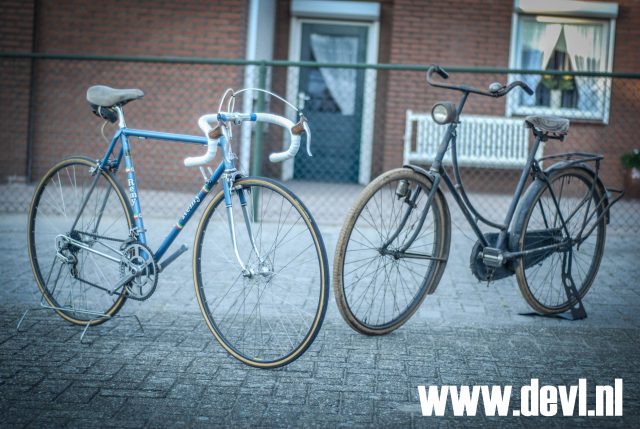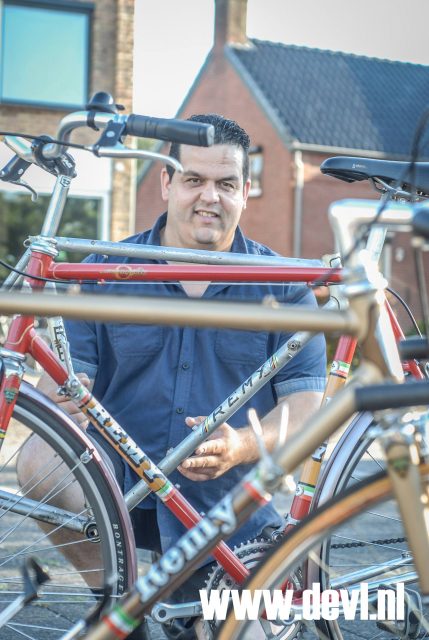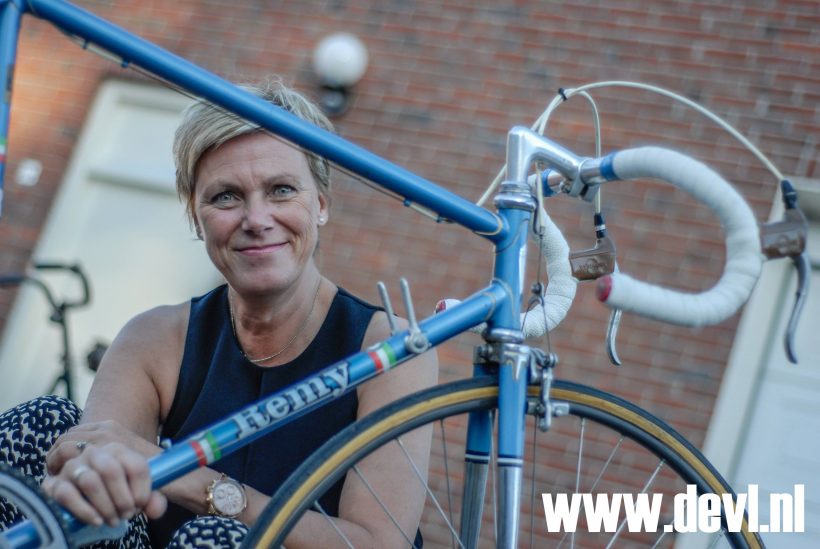Ossendrecht is part of the community of Woensdrecht, which profiles itself as the most cylcing-orientated community in the country. Ossendrecht used tob e base of a brand of bikes that was admired and ridden by the most famous cyclists of its day. Time to look fort he stories surrounding the Remy, Ossendrechts world-beating bike.
In the 20’s of last century, the Remy-brand was instigated by René Wouters and his wife Mary. René and Mary combined, that was Remy”. History tells a tale of Wouters being a man who loved his things tailor-made. When Wouters died in the 1950’s, the company was taken over by Henk van der Kloof, from the town of Zundert. Henks daughter Anita takes over: “At that point, my dad had a choice: he could start his own bike shop in Zevenbergen, or take over Remy in Ossendrecht. My mother was opposed to living in Zevenbergen, but she immediately gelled with Ossendrecht. That’s how it came to be. I was very proud of my daddy. He made beautiful things, and the whole cycling world adored him, and my mother as well. There always were many people around our house. We had famous cyclists visit us every day.”
“Remy, that was Ossendrecht’s local magic”, says Ernest Meylemans (63). As a little boy he was a common sight in Remy’s workshop. There he witnessed Henk van der Kloof and framebuilder Marten van den Bergh – known locally as “Marten van Toepse” – practice their art. “Marten van Toepse simply was extremely talented. He knew what a cyclist needed from a bike. And a Remy rode like no other bike in its day. That’s why so many famous cyclists wanted a Remy”.

Famous cyclists indeed appreciated Remy. “Six-day king” René Pijnen, best friend of Henk van der Kloof for example, rode Remy, as did Wim van Est. Jan Janssen too. Gerard Koel (75) also used a Remy. “When I moved tot his region in 1969, Remy was already a well-established brand. I asked Henk to build me a bike for criterium. I did a lot of those, that’s what made me my money. You could ask Henk for whatever you wanted, he’d simply build it, and build it well. Marten was a fantastic welder. That Remy was made to fit me and my needs, and it was light as a feather. In that time, if you wanted a state-of-the-art bike, you wanted a Remy. I drove Remy’s until I ended my career in 1974. The atmosphere in Ossendrecht was wonderful. Henk and Cor simply enjoyed it all. Their house was a sort of livingroom with an atmosphere you’re not ever going to find nowadays in a bikeshop. Time is money today, but for Henk and Cor it was the atmosphere what was important.” Jo de Roo (79) agrees with Koel on that. De Roo won the famous Tour of Flanders in 1965, riding a Remy. “Cor was an amazing hostess”, he says, “it was always pleasant in Ossendrecht.” De Roo originally comes from the province of Zeeland, but as a starting cyclist he couldn’t find what he needed in that region. So he went to Ossendrecht. Remy sold him his first racing bike in the 1950’s. “That was a black Arend, not a Remy”, he laughs, “i changed to Remy’s much later, when I raced fort he Televizier-team. That team was sponsored by a big bike-brand, but we still rode Remy’s, with the sponsors name stickered on them. Why? Because the major cycling brands didn’t have specialized racing departments then like they have today. You simply couldn’t win on those bikes. Remy’s were super light and tailor made. As cyclists we gave it our all to win, and Marten and Henk gave their all to build the best possible bikes. My victory in the Tour of Flanders in 1965, and in the “Omloop het Volk” in 1966 officially weren’t done using a Remy, but I know better than that.”
Henk en Cor van der Kloof and Marten van den Bergh have all passed away some time ago. So has Willem Pluijmers, who was the painter that gave many Remy’s their color. His grandson Fardo Verswijver (38) inherited some of the Remy-ideas from his grandfather. “Grandpa learned a lot in his time with Remy, and he taught me everything I know, also about how important it is to measure a bike, something Remy was one of the first to seriously look into. A Remy used to fit like a glove, and since i did a lot of races myself I know how important that is. I own two Remy’s. One of those was maintained by my grandpa in his bikeshop, that he opened after Remy closed down. I own a bikeshop myself now, where I use the knowledge my grandpa gave me on a daily basis. Remy holds a strong emotional value for me.”

That emotional value is even larger for Anita van der Kloof. “My brother didn’t continue the company, unfortunately. I sometimes think I would have done it, if I had been a boy, but that is merely a thought. I don’t think there would be a place for Remy in the current cycling world. That is simply too cold and too commercial. My father was more of a quiet man, very modest, a bit quiet even. Professional teams asked him to build bikes for them on a regular basis. He couldn’t sponsor them, simply because Remy consisted of only five people. There was a shop incorporated in our house in Ossendrecht, where many locals bought a bike in their day. Sometimes my father and his people would build a few thousand bikes a year, they simply didn’t have the capacity to sponsor a professional cycling team. But my father was very proud of all the interest Remy attracted, and secretly it hurt him to have to say “no”. I know deep down inside he smiled proudly when a Remy won an important race. The tradition was for a winning rider to come and bring cake tot he shop after a victory. Sometimes we ate cake every single day. The local bakery made a huge profit from Remy. If you know where to look you can still find many Remy’s around today. They museumworthy now. I’m glad Remy hasn’t been forgotten.”
The tale of Remy was published by De Zuidwestkrant in 2016.
